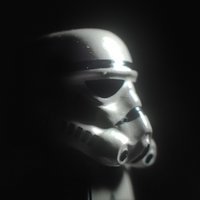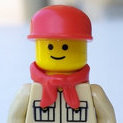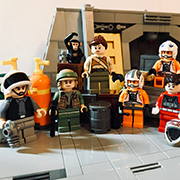Search the Community
Showing results for tags 'Instructions'.
Found 251 results
-
Just in time for Christmas, I built a model of the McCallisters' house from the movie classic "Home Alone". But of course not a playset in minifig scale like the IDEAS set, but a micro model at about 1:250. Of course my Architecture-oriented approach is quite a bit different from the playset approach of the IDEAS set. While the LEGO set is primarily interested in the interior of the house, my goal was to accurately capture the house itself as well as the surrounding property. I also chose a bit different colours, as I find dark red a bit more fitting for the house's brickwork. I also chose a grey roof primarily because it fits better into the colour composition of the rest of the build, but also because there really isn't much snow on the roof for the majority of the film. But even on this scale I tried to pay tribute to key elements from the film, like the tree house Kevin escapes to at the end or the garage the McCallisters forgot to close. And of course it features both Little Nero's Pizza bumping against the entrance statue as well as the van of the Wet Bandits. As a Christmas model it lends itself well to lighting, of course. I put 3 LEDs from LightMyBricks into it, one in the kitchen on the back and two in the main wing. The cabling fits well into the base and the power cable can be led out through a small gap in the back. There is an album on Flickr as well as building instructions on Rebrickable for the model as well. (I tried to use smaller images in the post to link to the corresponding Flickr pages so I could lay them out next to each other for a more streamlined presentation, but I still can't seem to figure out how to do a simple image link on Eurobricks. I hope these above images at least do link to Flickr.)
-
- architecture
- home-alone
-
(and 3 more)
Tagged with:
-
Book Review (Review by Thorsten Benter) Almost a year has passed since initial publication of this book. There are a number of on-line reviews available – this one on EB seems to come in a bit late. Well, I don’t think so, in contrast. This book is a comprehensive how-to-build-a-train resource rather than a compilation of what is out there. And this sets the book aside from so many others. It will be up-to-date as long as The LEGO Company produces bricks and sets. Plus, with the arrival of the Powered Up system, more space becomes available inside the train body as compared to comparable PF functionality: The dedicated receiver becomes obsolete and no line of sight is required for communication creating some additional space – space for sophisticated building techniques! This books tells you everything you need to know about the historical LEGO train theme development at TLG, about scales and widths, about pivot points, microstriping, SNOTing and offsetting, and so much more with relevance to train building! (Note: A PDF copy of this review with higher resolution pictures will be shortly available at Holger’s website) Summary: A must-have for every LEGO train fan, for people entertaining the idea of getting into LEGO trains, and for people who still don’t know that they will become train fans after reading the book Superb photography of LEGO models, outstanding renders of CAD models In-depth analysis and assessment of the different LEGO train eras Demonstration and teaching of advanced building and design skills My personal LEGO book score: 10/10 About the book: Author: Holger Matthes Published: Oct. 2017 by No Starch Press Inc., San Francisco, CA, USA. Hardcover, 135 pages + 90(+) pages reserved for 4 full building instructions (ICE train, gondola car, Swiss Crocodile, and a vintage passenger coach), 150+ most relevant and educational figures (excluding the beautiful chapter openers or page breakers as well as the set building instructions), 20+ tables including bulleted lists. ISBN: 1-59327-819-5 Price: € 14 (Kindle edition, Amazon); € 23 (Print edition, Amazon) both as of 9-2018. $ 19 (ebook only), $ 25 (ebook and print edition, nostarch.com) both as of 9-2018. The present English edition published by No Starch Press is based on the initial German edition “LEGO Eisenbahn – Konzepte und Techniken für realistische Modelle”, which was originally published by dpunkt Verlag Heidelberg, ISBN: 978-3-86490-355-7. The initial German edition of the book based on Holger’s manuscript composed in 2015/16 caught the attention of foreign publishers: It began with the present English edition in 2017. It then took a bit longer until the Chinese publisher “Posts & Telecom Press” (who has already published a bunch of LEGO books written by fans) very recently released the Chinese version: http://www.ptpress.com.cn/shopping/buy?bookId=0ed0cd68-ca59-41fc-9bf9-193b06089996 (ISBN: 978-7-115-48419-2): After publication in 2017, No Starch Press’ English version became the reference for further translations. In summer 2018, the Spanish (“LEGO TRENES”; LEGO TRENES https://www.amazon.es/TRENES-Libros-Singulares-Holger-Matthes/dp/8441540179) and the Italian (“TRENI LEGO”; https://www.amazon.it/Treni-Lego-colori-Holger-Matthes/dp/8868956411) editions became available. And the Russian version is on its way (sorry, Holger couldn’t tell me any further information about its availability): (Note that the Russian cover on the right is purely made up by me – Google translator says the Cyrillic headline reads “in preparation” – but who knows …) About the author Holger Matthes is a hobbyist who has been building with LEGO since 2000. He was involved in the creation of various official LEGO projects such as the Hobby Train set #10183 and frequently presents his models and gives workshops at LEGO exhibitions worldwide [copied from Amazon website]. Table of content of the book (short version) Part 1: Overview and history Introduction A history of LEGO trains Part 2: Building your own train models (My own creations – MOCs) Basic principles Designing your own models Case studies in design Part 3: Building instructions A note on the included building instructions Appended to the body of the book, you’ll find four high quality and carefully composed instructions in addition to two free online instructions: Inter-City Express (ICE; driving and trailer cars, PF motorization, windshield designs) Gondola car Swiss electric Be 6/6 “Crocodile” Vintage passenger car Steam Engine BR 10 (as bonus online available at http://holgermatthes.de/bricks/en/br10.php) Steam Engine BR 80 (as bonus online available at http://holgermatthes.de/bricks/en/br80.php) There is further information available online. Holger directs you to https://www.nostarch.com/legotrains; but most of the very valuable stuff is actually hosted on his website. I highly recommend to visit his site: http://www.holgermatthes.de/bricks/en/index.php. You will find a wealth of background information, tips&tricks, how-to, and much more. The Book Let’s face it: Almost one year after initial publication, Holger still sets the stage with this book for LEGO train fans. It will be tough to get it much further; not on 135 pages (not counting the instructions pages), not with regard to the topics covered, not with regard to the width of the audience addressed. This book provides diverse perspectives on the art of building LEGO trains, coaches, and rolling stock – and is at the same time always determined, focused, and addresses most relevant “issues”. Train builders repeatedly face tough challenges: A train is not a building, which simply resides in all its beauty; rather trains are work horses – either hauling heavy cargo loads or endless passenger coaches, or switching rolling stock for hours and hours in a train show – or on your personal layout. At the same time, a LEGO train is “beautiful” and “esthetic” in the recognition of a train fan - as a building is for City fans. However, to be able to render real trains into LEGO models, regardless on the scale used, requires some serious knowledge about the myriads of LEGO bricks available, about advanced building techniques, and even electrical wiring skills. There simply isn’t much space in a LEGO train. Space as in “Space … is big. Really big. You just won't believe how vastly, hugely, mind-bogglingly big it is. I mean, you may think it's a long way down the road to the chemist's, but that's just peanuts to space.” [Douglas Adams, The Hitchhikers Guide to the Galaxy, 1979]. It is usually >extremely< packed inside a LEGO train model, particularly when electrifying it. Shaping the outer appearance with advanced building methods such as SNOT or angled and carefully secured pieces usually eats up all the space inside the hull. And lastly: Trains need to be sturdy. They not only haul heavy loads – they also have to run endless distances on track – in the best case on long stretches of straight track and smooth curves, here and there a bit bumpy – in the worst case negotiating endless and sharply bent curves and switch points in complex rail yards. This is exactly what Holger addresses in his book: How to achieve a sturdy, reliable, and at the same time esthetic and beautiful train. And we should just get it straight from the very beginning: Stickers are frequently recognized as the “icing on the cake”. And this is certainly true. BUT: Believe it or not, you can also legally “build” tiny lines, sloped coloring, narrowly split windows and much more when using advanced building techniques! And that sets aside this book from so many postings, building instructions, and other resources: Holger shows us how to accomplish “brick-built stickering” by using the endless variety of bricks and plates to build streamlined and nicely accentuated and smooth surfaces – rather than using the bulky, essentially non-LEGO-philosophy-but-by-TLG-released ICE #55768 nose with stickers attached all over it … There is so much more in the book. This is what I am trying to highlight in the following. Holger’s book is a must for us all: Beginners, advanced builders, as well as Train Tech gurus! And those who believe that they already are. One more thing to add: Photography and CAD image rendering. Or: A picture is worth a thousand words. Holger says: “The biggest thank you goes out to my old friend and master photographer Andy Bahler, without whose pictures this book would have been useless. His commitment, night after night, was above and beyond expectation …” The pictures are spectacular – you will notice right away. Organization of the book There are three parts in this book, although there is no such explicit assignment in the table of contents. Holger tells us on page 2 though: “The first part of the book gives an overview of LEGO trains over the different eras, covers some history, and answers questions about how to combine old LEGO trains from the attic with today’s kits. The second part of the book is about building your own LEGO train models, also known as My Own Creations (MOCs). Using my many years of experience building LEGO models, I’ll show you how to create proper train models, covering both the possibilities and the limitations. Finally, the book ends with step-by-step building instructions for several models.” Usually, the table of content is a good starting point for the organization analysis. However, this book is extremely focused and self-contained in each of the chapters of the three parts. This is very helpful (and also very different from other books), as the LEGO universe, including train worlds, is as diverse as it possibly gets. The number of pieces alone currently available through TLC’s official channels such as LEGO sets, PaB, and LEGO stores – or even more so – through the uncountable BrickLink stores around the globe is truly mind-boggling. Well, it is not only the sheer number, but more so the endless combinations possible – and what you achieve with such. Chances are: One gets rapidly lost and a little frustrated. Exactly this is NOT happening when “reading” this book. OK. We do it differently – as it seems appropriate for a “different” book: We walk through, as the very nice and focused organization of the book simply allows that. Part 1 “INTRODUCTION Decades ago, the toy designers at LEGO likely never imagined how durable their work would be. Today, parents can dust off their childhood LEGO trains and play together with their children who have just received their first brand-new LEGO train set. And fans of all ages can revive older sets and parts to create entirely new models.” In order to prevent such an almost natural “disorientation” or lost in parts and ways to connect them, in part one the book begins with a review of on-line resources. Information-, instruction-, and brick-availability-wise. Holger lists only the most relevant internet locations. Start here and progress further on your own. It makes your building life so much easier. As with every printed book, online references may become outdated at some point in time. Holger names thus only most reliable web portals, which will most probably exist for a long time. “A HISTORY OF LEGO TRAINS Let’s explore the evolution of the LEGO train systems from the earliest set to the present.” Next, there is a historical review of which type of train system was available at what time defining an era. This is rather significant. First of all, this approach results in a theme classification rather than a temporal evolution of sets: The blue, grey, 9V, RC, and PF era. As the pieces from different areas are naturally largely interchangeable (otherwise it would not be LEGO!), you may mix them as you see fit. Nevertheless, each era has a certain typical appearance – if you want to capture that, you need to know what was going on during that particular era. As an example, people in love with the grey (12 V) era often capture the look and feel of that time – for example studs everywhere, not many curved bricks/diverse slopes (as they were not available at that time) – rather limited colors schemes, black, red, and yellow ... The reader learns what has been produced when and in what color scheme. There is also ample of information on the technical features of each era – it appears as if the author is deeply involved and well connected in the LEGO train community – all the way up to participate in the design of selected sets. Holger shares his knowledge with the reader – always in a concise and focused way. It is pointed out that Holger is not even attempting to compile a complete list of sets available within the different eras – in contrast, he is summarizing the unique era characteristics and features. He focuses on power sources, tracks (including switches and crossings), and other elements (wheels, baseplates, in addition to unique features, such as trucks, couplings and buffers). The grey (12 V) era sections stands out of course, as this was the most diverse and most creative train theme ever (IMHO, of course!). Here you will find an – again unique – compilation of “remote-controlled accessories”, “windows and doors”, “light bricks”, “weighted bricks” … What I personally find extremely useful – and it must have been a considerable effort – is i) a summary table, listing the most important features of each era, and ii) Holger’s evaluation of these features he headlines as “Seen from today’s perspective”. Even long-time and experienced train enthusiasts will surely find valuable information in this chapter! Part 2 “BASIC PRINCIPLES Let’s dive into the world of LEGO elements and explore the endless ways to connect them.” Now that one knows the individual features of the different eras, Holger opens part two of the book with a compilation of relevant LEGO pieces for train building. It is really surprising how many there are! I have built trains myself – seeing all the various elements nicely grouped and organized makes it so much easier to get an overview of individual pieces, select the ones you may want to try out – and compare them to other options. This section is extremely helpful when you start off with a new model – or when you want to overhaul an already existing train. In the following section, Holger introduces typical train specific building techniques (although you can use many of them throughout the entire LEGO universe!). And is not surprising that there are eleven dedicated pages on SNOTing and fractional-plate offsetting in all three dimensions. These are the most crucial techniques when shaping the look of a train. SNOT (studs not on top) is a powerful technique and has become very popular among train fans. Originally rather restricted to a few elements, which allowed to “reverse” the building order, the LEGO Company has released a broad variety of SNOT elements over time. These are of course also shown in the preceding chapter on relevant LEGO train pieces. I’d say that this chapter is extremely important for beginners and of great interest to experts as there are various approaches shown side-by-side. At least for me this chapter is highly inspiring. The same is true for plate offsetting, i.e., building with only one half stud or even less displacement off the stud grid. First, the look of a train becomes much smoother even when not using curved bricks; secondly, this technique allows you to literally “build” colored surfaces with fine structures and even thin stripes (called microstriping). Without using stickers that is … Ever used minifig guns to create pantographs? Or ice skates as door handles? No? Well – Holger shows you! “DESIGNING YOUR OWN MODELS You might be wondering if you’re ready to begin making your own models. Which train should you build? Maybe you should start with the commuter train that takes you to work every day, or a freight train? And who hasn’t dreamed of a beautiful steam engine in LEGO?” Now we are getting down to business. The following two chapters of part 2 are not about “building a train” – they are about “how to do it right”. We are talking about scaling and modeling rather than “pushing along”. Before Holger goes into details though, he points out the importance of thoroughly choosing a scale. This is an extremely important decision to be made when attempting to model a real-world train. How much detailing is required? How much abstraction is allowed? Citing Holger again (page 73): “Building a recognizable model isn’t about scaling every part exactly, although proportion matters. Intentionally omitting some details or exaggerating others is usually necessary. Scale modeling with LEGO is a bit like drawing a caricature: the end result may not be an exact likeness, but it is recognizable and undeniable.” We learn about model scales (1, L, O, HO …), alternative approaches (scaling by wheel size) as well as choosing a model width (6-, 7-, 8-stud-wide). Don’t mix these up – almost any scale may be used for any track width! There are so many diverse examples here on EB. Holger narrows the scope of widths covered in his book to 6 - 8 stud wide (see cover page of the book), as these are the widths most builders choose – in addition to the official 6-wide LEGO models. He discusses the advantages and downsides of each of these widths in detail. A very important aspect when designing and building a LEGO train – regardless of the model scale – is the official LEGO track geometry. Maximum distances of fixed axles, alleviation of this rather restricted distance using articulated single trucks (a theme repeatedly discussed here on EB), sliding middle axles in three axle trucks – you will find all the answers in this book. When it comes to attaching cars to each other – even more design aspects have to be considered, which are all discussed: Pivot points vs car distance, additional pivot points to reduce car distance, the effect of pivot points on design issues, to name a few. And then: Steam engine design: 7 full pages! As far as I am concerned, steam engines are the most challenging models to render in LEGO. To say it with Anthony Sava’s words: “I'd buy a set with a steam engine in it, but I have little interest in buying a box on wheels.” (EB Forum, April 2nd 2018). Holger shows us all the challenges and caveats. The remaining sections in this chapter are: Power and Control, discussing mostly the implementation of PF elements, Modeling Details, and Track Design and Layout. Again, extremely valuable information and guides are given. One comment on third party suppliers: At the time of writing this book, both SBrick controllers (as a replacement for PF receivers, featuring wireless Bluetooth connectivity) as well as ME Models (as a supplier of wider radii curves) were actively present on the market. As of now (i.e., August 2018) though, the new LEGO Powered Up system introduced lately makes SBricks for trains almost obsolete – and Me Models have gone out of business some time ago. There are a good number of very good 3rd party alternatives for additional track pieces – large curve radii, complex switch point geometries to name only a few. They come as superb injection molded pieces which are almost indistinguishable from original LEGO track, as well as 3D printed varieties. I believe that a book of the format Holger has chosen simply does have to deal in-depth with such developments as they are much more volatile than almost any LEGO product. Taking aside the LEGO RC interim solution of course. But again, Holger gives a full account of why RC happened at all and why its lifetime was even shorter than that of many 3rd party small businesses. I really enjoyed this section very much. Regarding very recent developments by TLG naturally not covered in the book (the original German manuscript was written in 2015/16): The introduction of the Powered Up system leaves much more space within a train engine so that all the building tips and tricks provided in Holger’s book become even more intriguing! It appears as we can even more freely combine advanced power/remote control options with the present advanced building instructions. Which makes this book even more valuable! “CASE STUDIES IN DESIGN Armed with the tools and knowledge about LEGO modeling covered in the previous chapters, we’ll now take a closer look at the actual design process using some of my own builds as a guide.” This chapter needs to be explored – interpreted – by yourself. This is – as far as I am concerned – the heart of the book. Here you will learn how to begin designing a model. I find this part the most difficult: How to begin – looking at the all the bricks, plates, slopes, clips, there are so many of them … so we should take this to our heart: “Designing a model is a creative and personal process: there’s no right or wrong way to build a successful model. The guidelines in this section are meant to get you started. You’ll certainly develop your own strategies along the way.” Along with: Decide on a scale and choose the width: 6-, 7-, or 8-wide? Decide how the train will be powered and what type of track it’ll run on. Choose a target audience: should it be a realistic, recognizable model, or are play functions more important? You will notice: This is about >you<! Nevertheless, you will also learn a lot in this chapter. Holger has chosen a regional express train (Bombardier double deck train), a powerful electric locomotive (Siemens Vectron engine), and a (well, Holger is German after all …) steam engine (BR 10) as case studies. This is a very clever selection – as the techniques he shows apply to almost every engine I am aware of – including American diesels as well as American steamers … or all the various European trains, Emanuele (EB member LT12V) is currently presenting here on EB … And finally … Part 3 “BUILDING INSTRUCTIONS! Get inspired with these step-by-step instructions for building an Inter-City Express, a simple gondola, a Swiss Electric Locomotive Be 6/8 “Crocodile,” a vintage passenger car, and a steam engine.” From page 136 to 227 you will find first class, high(est)-quality building instructions for the above referenced models. There is nothing more to add. As said: This book is a must … Play Well! @Jim Thank you very much Jim for giving me the opportunity of writing this review for EB - it was a great pleasure. And for sending me this wonderful book! @HoMa Thank you Holger for writing this book. And for all the additional information you gave me when writing this review and for your comments! Thanks for reading, Thorsten
- 11 replies
-
- 12v
- instructions
-
(and 8 more)
Tagged with:
-

[MOC] Unimog 437
Thirdwigg posted a topic in LEGO Technic, Mindstorms, Model Team and Scale Modeling
I guess you could say I couldn't make up my mind about the kind of Unimog I wanted to make next. So I decided to make a platform that would support multiple versions. Features: Interchangeable platform Long and short wheelbase options Standard and Doka cabs, removable Manual control PF control (drop in) Front and rear suspension Steering 4x4 with I-4 fake motor Opening doors and hood Tipper bed options Feel free to check out thirdwigg.com to learn more about the build. Manual SWB with tipper bed. Manual LWB Doka with tipper bed. Power Functions (XL drive, Servo steering) LWB with cover. Manual LWB with canvas bed showing the suspension travel. You can find more pictures on my flickr. I have been adding instructions for the various versions here, and more will be added over the coming weeks. Someday I'll make a camper, because, everyone needs a camper. This was a fun project, and I loved the way it turned out. I have the LWB on my desk right now, and I keep getting distracted from work. I hope to add additional options for the system at some point, and will take other suggestions for versions to add. Hope you enjoy.- 28 replies
-
- instructions
- suspension
-
(and 3 more)
Tagged with:
-

The Sun (GBC) Instructions
Ankoku posted a topic in LEGO Technic, Mindstorms, Model Team and Scale Modeling
The Sun is a GBC module created by @PG52 The video of it in action is here: With his help, regarding additional images, I have created some PDF Instructions for it. The PDF file and Parts lists can be found here: http://kanatta.com/GBC/TheSun/ If you want to link to the instructions etc., please just link to that page, as it contains mods, additional images, credits etc. The parts list isn't included in the PDF as Stud.IO isn't very flexible with that sort of thing. The digital file is not currently available. Known issues: I can jam and doesn't have a clutch system to deal with that. It is also a self feeding module. @dunes is currently working on a GBC circuit friendly version. In the instructions, there is a mod to replace the curve at the bottom of the top ramp. This is to remove the twist the flexible hoses cause which pushes the top ramp into the wheel. Notes: For the most part I have used commonly available pieces in regards to certain axle/pin colours. Where this isn't the case, it was done for specific aesthetic reasons and you can of course use the more commonly available colours. I think I mainly just did this for "The Sun" sign. Thanks to: @PG52 for creating the module in the first place and for the additional images. @Doug72 for helping to test the instructions. Additional: I have also added a mod for the Cardan Lift and will be doing instructions for Akiyuki's Cup-to-Cup v1.1, which is the version he is currently running, rather than the one which got reverse engineered close to the time he created the module. These are and will be available here: http://kanatta.com/GBC/ Enjoy.- 63 replies
-
- instructions
- gbc
-
(and 1 more)
Tagged with:
-

Stud.io colors in instructions
Redhead1982 posted a topic in Digital LEGO: Tools, Techniques, and Projects
I've been googling for an answer, and I can't find any. I'm fairly new to Stud.io, so that might be part of the problem. The problem I have is that some LEGO colors don't show properly in Instructions mode. I worked on a mosaic design in Stud.io, creating this Pink planet, and while I tried to make instructions for it (for my personal use), I couldn't get the colors right. Lavender (BL color ID 154) looks white in the top view. At the same time, the colors are shown properly in the angled view. I found a similar issue for another mosaic project in Stud.io, and it's bothering me. I'm trying to make a mosaic as a gift and would be great to include the top view pictures as instructions. However, the colors again do not show properly. In this case, light nougat looks like tan. It's not a problem per se, as there are no tan parts, but I'd love to find out what I'm doing wrong. So if you know any tips on how to solve this, I'd be all ears. Thanks.- 2 replies
-
- stud.io
- instructions
-
(and 1 more)
Tagged with:
-
Before you read any further: I want to give massive credits to RenegadeClone (or his brother.. or both.. it's confusing) for coming up with this great MOC and leaving enough instructions for me to reconstruct the model. My version is 90-95% the same and I can only take credit for making the model and some small differences in detail (I'll get to those later). RenegadeClone's done a great job. You can find the original topic here. Having said that, things are easier to build when you have an LDD file. A small introduction I'm Krispy. I've been lurking here for a while, taking in ideas and techniques. Now that I've started building again, I figured it's good to share. I'm a big fan of Star Wars universe starfighters, but only the classic trilogy and the stuff after that. I love space sims and "Tie-Fighter" in particular; I've wasted half my childhood on that game . And now I've decided to collect Lego version of the starfighters from that universe. In minifig-scale. I was a little bummed out that TLG doesn't have a proper B-Wing set. Bummed out until I found RenegadeClone's MOC. The Model B-Wing v1.1 by Krispy's brick stuff, on Flickr There she is, rendered using LDD2PovRay. Total part count: 951. Ouch. There are small differences with the RenegadeClone's original; most concern the cockpit: The cockpit is all light bley; this meant using some different parts The rear cockpit section (with the curved slopes) is completely different in internal construction. The slopes are now attached using 3 stubs making the use of rubber bands unnecessary (I dislike rubber bands). The pilot now has a seat (in dark green!). Flying a B-Wing is tough enough without the physical discomfort.... or so they say. The internal structure of the main wing and the engines is different. I only knew the outside dimensions, so I had to reconstruct them on my own. Internally this B-Wing is probably rather different. Below you will find all the files you need to source the parts and make the model. The LDD model is made using LDD 4.3.5. The partslist spreadsheets was made using LDD Manager, but I've added some extra columns to keep track of the parts that you have ("Have" column) so you can see which bricks you still need. For those of you who don't do LDD, I've exported the instruction to html and put them in a zip; they should work on any browser. The Files The LDD file: v1.0 / v1.1 Partslist (v1.0): XLSX (office 2010) / ODS (openoffice) Building instructions in html (v1.0): link LDD file of the display stand: link If you want to figure it all out yourself, stop reading and start building. Below I've posted some notes on sourcing the parts and building the model that you may find useful though. Sourcing the parts Please note that there are a small number of rare-ish parts used in the model, so check if you have these or are able to order them before you start your Bricklink frenzy: Large hard plastic wheel in classic grey Wedge 4 x 4 (Slope 18 Corner) in light bley; you'll need 4 Most parts in sand blue 4L bar in dark grey/dark bley; dark grey shouldn't be too hard, but dark bley is rarer 8.5L Hose in classic grey Also note that if you need to source almost all parts (like me; my lego is older, so I only have classic grey), this beast will set you back considerably. It has almost 1000 parts. By my estimation I've spend somewhere between €100 and €120 on parts (about $125 to $140). It's not cheap. If you use LDD Manager to check if you can do other colours instead of sand blue, you will only find a small number of basic colours. This is due to this brick. If you want to know what your real options are, paint this brick black in the model. If you are having trouble sourcing sand blue parts (I'm looking at you fellow europeans), dark bley offers a good alternative though your model will look more like the UCS B-Wing that way. Building considerations It's possible to build this model using the LDD generated instructions. I've done so, proving they actually work, but they are a bit weird and unlogical. The LDD model has been grouped in to logical groups, so you might want to check those. As reference, I've rendered a picture showing these elements. Minifig-scale B-Wing v1.0 in parts by Krispy's brick stuff, on Flickr Below I will note some things you want to look out for. Engine covers by Krispy's brick stuff, on Flickr Build these engine covers seperate and add them to the model later (after step 180 or something). Engine (build this first) by Krispy's brick stuff, on Flickr That means you want to build this engine part first. Exhaust close-up by Krispy's brick stuff, on Flickr Note that the technics half pins do not go in all the way. That's not a bad thing though: you now have the option to add a 2x2 dish giving your exhaust the same look as the offical TLG sets (eg. the 9493 X-Wing). Technics tubing not in instructions by Krispy's brick stuff, on Flickr Note that this piece of pneumatic tubing is not on the LDD model. The holders are though; look at the completed model (all the way below) to see where it slots between the two torpedo launchers. Fix for curved plate problem by Krispy's brick stuff, on Flickr I had a problem with the narrow 1 stud wide cover plate for the rear of the main wing: it curved outwards (to the left in this picture) because a 1x12 plate I used wasn't straight!! Using this modification at the bottom of the assembly, I was able to hold it in place. Cockpit axle mount thingy in place by Krispy's brick stuff, on Flickr Notice that I used old school connectors with studs on the side. This means the model is a bit sturdier on top (also I have, like, tons of these parts). Cockpit section by Krispy's brick stuff, on Flickr Cockpit with seat. Notice that the headrest has two 1x1 dark bley plates instead of one in the LDD model. This depends on what helmet your minifig pilot is wearing. Build complete! by Krispy's brick stuff, on Flickr Build complete! It's big, it's heavy. If anyone has suggestions on a stand that works for this beast, I'm all ears. I hope you've enjoyed this little write-up. Good luck and happy building if you're going to attempt one... trust me, they are worth the effort: the build was definitely one of the most challenging I've done so far! update 13-01-2013: A stand I've updated the files section with a LDD model of the stand I came up with (see picture below). It's bulky, but sturdy and allows you to show off the model with open s-foils! Stand - front by Krispy's brick stuff, on Flickr update 19-01-2013: version 1.1 I've updated the model to 1.1. Grab the new model file from the files section above! What is different you may ask? Well, there's somewhat less studs on the outside of the model. Oh... and the lower part of the internal skeleton has been redone completely. It definitely feels more rigid now. Check out the differences below! Even if you don't want to update your model with loads of tiles, I would recommend redoing the skeleton. B-Wing v1.1 Skeleton update by Krispy's brick stuff, on Flickr
- 125 replies
-
- starfighter
- ldd
-
(and 3 more)
Tagged with:
-
The Y-45 armored transport hauler, also known as AT hauler, built by Kuat Drive Yards and used for the Galactic Empire, with its very agressive and intimidating design, was a great Midi-scale challenge. Accurately Microfig-scaled (or trophy-scaled), and made of 623 pieces, this MOC features all the typical angles and details of the original cargo ship: agressive cockpit shape, intricate wing angles, lower bridge with its guard-rails and stairs, ion engines and magnetic clamps, holding on a single, secure Lego stand. With very simple connections, both arms can be installed upwards to put the ship in landing mode. ► Instructions for the AT Hauler are available at Rebrickable or via email at flyinspace.mocs@gmail.com More pictures on my Flickr page.
- 3 replies
-
- star wars solo
- at hauler
- (and 10 more)
-
2021 remake! Initially it started as a minor update to fix few issues, most notably weak guns/windshield attachment, but over time scope of the changes grew and grew and grew. Changes: - Cockpit now can has space for the pilot in any type of the helmet, including the grossly oversized one; - Cockpit interior now features new controls layout and few more details; the "bowtie" detail taken almost 1:1 from 20feet's variant, with a slight modificiation to make it match the intended "flow' of the cockpit a bit more to my liking. Big thanks here! - gun and windscreen attachment is redone to be much more solid; though this particular change was already implemented in First Order TIEs; - top dish was replaced to use 4x4 one. This is a bit controversional, but bricklink prices for the 6x6 one are extreme, because they appeared on only one set some time ago. 4x4 is much more popular and so this is a better option for a model which is supposed to be built by other people too. - side struts were redone to resemble original ones a bit more. I had great help here from 20feet who helped me to go through few ideas and find one which is a nice compromise between screen accuracy and fitting rest of the ship's styling. Thanks again! - side struts were made longer, as I made a slight scaling mistake in the original TF. - wing/panels are basically an entirely new build. The shape, which has proven to be a little bit controversional due to being much more rectangular, is more similar to what movie and Rogue Squadrons game TIEs are using. I know it is not 100% perfect and a bit too rectangular, but this particular layout enabled me to use most of 1x2 grille bricks, aside from the slopes. I believe it is a good trade-off and the angle is definitely closer to the original, even if wrong in the other direction now. - I also tried 20feet's vertical stacked bricks idea and it looks great - on black background. It is included in the instructions pack, and is probably the best choice for people who will display the ship against black background. Otherwise, gaps between bricks are quite noticeable. Still - a super interesting idea and one which got implemented! - New wing cores: Hexagonal, finally! Again thanks for 20feet's insistence on making them better! I thought my original idea was good enough but it was worth pushing a bit more! - New color variant! This was Charlie's idea (one of Brickvault leads) and I was skeptical even after building it. Thankfully, he insisted and so, over time, this variant grew on me to the point that I now believe it is the best looking one. It is a bit assymetrical but overall a compromise worth doing! - New universal stand debiuts here, and I intend to use it - in various similar versions - for all future ships in this size. So, yeah. Quite a remake. I apologize for delaying it this much, especially after repeatedly telling people the update is "soon". Sorry. This is the first time since 2019 where I finally was able to get everything right. Since T/F shares almost entire core with the T/I, I redid it too: Interceptor shares most of the changes with the Fighter. Initially I did not want to redo the panels - I thought they were perfect, but, well, yeah. They were not. Having Rogue Squadrons 3d models as the sources enabled me to get proper dimensions finally. Ultimately, the panels simply required lenghtening the back part and making those weird offset guns at the tips. I still believe it is an odd choice, but nonetheless, I tried to replicate it. The red one is a Royal Guard TIE Interceptor and aside from the obvious new racey paint scheme, it also features smaller additions to the wings. I tried to keep the angles same as on the main panels, which was quite a challenge, but eventually it ended up being perfectly possible. At this rate, 3.0 is scheduled for release around 2024. Let's place bets on what will change, and please tell me what's the weakest part of those designs, so I can focus on them in the future! I want to ditch 3x3 dome pieces as they clog up the interior, and this probably will be the focus of 3.0 - if I get some good ideas to try. And who knows, maybe I'll be able to make a perfect T/F wing panel this time? --------------------- Yet another LEGO TIE Fighter. How far can this classic design be pushed? How many ways are there to build an eye sandwitched by hexagonal solar panels? Is there a perfect design already? This is where beauty of LEGO as form of modelling strikes with full power, as answers to these questions are: Very far, infinite ways, and no, there is no perfect design available and never will be. In 2014 I have built this: It worked, and I think for 2014 and what was available back then, it was pretty good. It had obvious flaw though: no space for a minifigure, and it was also a little too small in scale. I was limited mostly by the fact there were no proper cockpit pieces, and my attempt with literally the only other one was... not spectacular, not to mention it needed painting with A LOT patience required. The new model takes advantage of this cockpit piece, which allowed me to push that original 2014 design further. I know, I am late to the party, years - literally - behind other designers of great TIE models, like Bricks Feeder or Rebel Builder, yet I hope I can bring something new into the T/F building scene. Originally I thought I would just stretch the build here and there but no, heheh, no way. Literally the only unchanged parts are the eight quarter (or one-eighter?) dome pieces, which are to me still the only way to have smooth and roughly spherical design without holes all around. Unfortunately when we look at a closeup of a real movie-filming model of the T/F we see how far are we from true modelling but I say we're collectively inching towards it pretty nicely. I have said this plenty of times but original designers of TIE Fighters really did all they could to make them unbuildable properly, naturally unknowingly - who would think adult guys 30 years in the future would try to recreate the design using perhaps the weirdest medium available?. The T/F is just a sphere, two struts and two flat hexes. Except: 6-diameter central cokcpit piece would require a 9-diameter ball, minifig-scaled TIE would require an 8-diameter ball and don't even get me started on sources for TIEs dimensions. If you think that Illustrated Guide To Star Wars vehicles is helpful, well, not much. I dare to say this book did awfully lot of harm to LEGO Star Wars MOCing scene. So is my TIE perfect? No, not yet. I promise though, I did all I could to make it as good as possible, with no compromises made. And this time it houses a minifig! The design is super sturdy to my standards, nicely swooshable - for a reason, but I will get to that later. Naturally having a T/F built opens a way towards the Interceptor, which for me is among the best looking spaceship designs in any sci-fi. While the core design is similar, the ball has some differences, mostly to accomodate longer struts. This is because LEGO curiously didn't develop 2x9 plates and for once I was in a situation where I can't really replace 2x9 plate with anything without compromising structural integrity. Having that solved I went onto the wing design and OH GOD INTERNET WHAT HAVE YOU DONE. If anyone knows angle on the panels and can prove it, gets a free beer. With shipping. Because the wings are angled in all dimensions, good luck guessing proper values from photos. Because of the IGTSWV book, half of the models (and I don't even mean LEGO models) existing are wrong. And then because of SW animated series, the other half of the models are also wrong... ...so my source of reference was this: Then after having all that done, I experienced another unexpected problem: The ship is top-heavy and won't stand straight. I added tiny legs on the bottom edges of wings which help a bit, and because the design is quite sturdy, the T/I requires no stand. There you have it. Yet another T/F and T/I. I hope you like the designs and I hope I managed to introduce something new to the very competitive scene. Enjoy! ...but wait, there is more! I would not build these models if not a commission request from BrickVault: https://www.youtube.com/channel/UCrhb3SP2lZBgguLHIWWuHOQ Originally it was meant to be just a few TIE models based on the 2014 design I had, just LDD files, but over time we developed a much more interesting designs and... instructions for each of them! The instructions are paid and please understand, it took weeks to develop them, error-proof, make the experience enjoyable and builds sturdy enough to be handled easily. Normally I do not make instructions, as I prefer to build with real bricks than to do electronic designs. The instructions are designed to have dozens of simple to follow steps with just few pieces per step, have submodels where needed, parts list for each step and a total bill of parts at the beginning. Additionally, in few places, there are notes to watch out for some particular details. I can fully understand now what LEGO designers go through and I can imagine amount of effort required for making instructions for larger and more complicated designs. I am pretty sure it took more time to design instructions for the recent UCS Millennium Falcon than to design the model itself. Thanks for watching and Happy New Year!
- 108 replies
-
- instructions
- interceptor
-
(and 9 more)
Tagged with:
-
Nov. 2015 Initial Post: Hello Eurobrickers! I have a great announcement for you guys, especially those who are interested in Cavegod's UCS AT-AT. Over the past month or so, I have worked a countless number of hours in order to bring all of you guys something that this MOC deserved ever since its creation, a proper instruction manual. Yes, that's right, the famed issues of LDD will no longer be apart of this project thanks to this manual. Now I'm sure you're wondering, how big is a 6000+ piece manual? Well, to answer that question, the manual is a massive 1,089 pages. No that is not a typo, ONE THOUSAND AND EIGHTY NINE PAGES!!! A special thanks goes out to both Cavegod and drdavewatford. Cavegod designed a masterful MOC, one of the greatest ever, and drdavewatford was kind enough to allow me use of some of his photos throughout the manual. This could not be achieved without you guys! Enough of me talking, here are some images directly from the manual: (Initial images removed for clarity on update) Oct. 2020 Instructions Update: Almost five years after its initial release, I'm thrilled to announce that the remastered instructions for Cavegod's AT-AT are complete! The instructions feature updates that make this build SO much easier and affordable. The most important things that are included in the updated instructions are: Redesigned Legs. These new legs have a technic interior and erase any issues that occurred with the original leg stability Reinforced Body Frame. The handle is now incredibly sturdy and the technic structure that is housed within the body is significantly more sturdy Cheaper Pieces. After several years it was time to swap out the expensive parts. The parts and MOC are now much more affordable. Display Base. What MOC would be complete without a display base? I designed a large black display base that includes technic framing to snap in the feet, a much better alternative to the old method of tires within the feet. The base also features several snow-covered rocks to imitate a Hoth landscape The MOC now consists of 8,935 pieces and measures: 34" long 18" wide 30" tall The instructions are now reduced down to 550 pages. More information about getting the instructions and free access to the parts list can be found here Pete and I are super pumped to be sharing the update with you, and I cannot understate how much better they've made the build experience and final MOC. If you already own the instructions after getting them from me in the past, you should have received an email detailing how to obtain the updated instructions. If I missed you just shoot me a PM or contact me via email at alloutbrick@gmail.com and I'll get your upgrade over to you. Here's some photos of the update:
-
Hey guys, I’m searching MOC instructions and LDD files for my near-future huge Lego city. I plan of course doing some MOC modulars but there are some very nice MOCs created by other people! I made a list of all the designers I found, I hope that list helps some other people who search modular instructions! Here are the MOCers with instructions that are definitely worth looking at (with no particular order): —Brick Ative (by @lookl and @Pakita) ebay Rebrickable —SteBrick (by @stef2280) Bricklink Stebrick Rebrickable —Snaillad (instructions on sale by @2013-lego) (by @snaillad) ebay Rebrickable —Sheo (by @sheo) Rebrickable —peedeejay (by @peedeejay) ebay Rebrickable —bricksandtiles (by @Giacinto Consiglio) ebay Rebrickable —Kristel (by @Kristel) Rebrickable —brickcitydepot (by @brickcitydepot) brickcitydepot ebay Amazon no starch press Barnes and Noble —Ryan Taggart (by @ryantaggart) snakebyte.dk LDD File of Construction Site –geo.gr (by @Gunman) ebay —BrickToyCo (by @Tobysan) BrickToyCo —hermez (by @hermez) Rebrickable —mestari (by @Mestari) Rebrickable —Huaojozu (by @Huaojozu) Rebrickable —2013-lego (by @2013-lego) (his own designed modulars) ebay Rebrickable —Duncaadkin0 (by @Dakar A) ebay —BrickBuildersPro (by @lgorlando) BrickBuildersPro ebay Amazon —The Brick Show Shop The Brick Show ebay —andrepsramos ebay TISMSTORE Rebrickable –Brickstruct Bricklink Brickstruct —10214 Alternative Build (by Garom) Rebrickable —The Magic House (by valgarise) Smart Bricks —Bob's Burgers (by jtam1608) ebay —Villa Maison (by @marcosbessa) (found the LDD file on LDD gallery as it’s no longer available in his own website): LDD File —Train Station (by @LegoWolf) (link to download the LDD file is on his Flickr): LDD File Here are some other ones (those which doesn't really interest me but I'm sure that will interest many others): —SkywardBrick Rebrickable —TheUniqueBrick TheUniqueBrick Rebrickable ebay —A *Deal* 4 U (by waltzking) Bricklink —Bricker and Co Bricker and Co ebay —Bjor Schoute ebay —sabriyo Sabriyo Customs ebay —Bauanleitungenmartin ebay —Berth Rebrickable —Soar Brick soarbrick ebay —gryffindorcommonroom ebay —scottcdavid ebay —sodabilly ebay —bolbuyk Rebrickable —deconstructor1 ebay —jval (Need for Brick) Bricklink Rebrickable —Fully Brick Models Bricklink —Brick Vice Bricklink Rebrickable —BrickusMaximus Bricklink —SonicSunday Rebrickable —Brickalive Rebrickable BlocK Shop —custombricks.de CUSTOMBRICKS Rebrickable —The Royal Church (by ateameric) Rebrickable —Alternative for Town Bridge (by Albertovax Corner) Bricklink —Bowling Alley (by drtyksh) ebay —Book Store (by Lair of Maedhros) Bricklink So that’s all I found. Maybe you wonder “why he’s asking for new instructions, he already found enough!” I ask it because I’m just purchasing/will just purchase the instructions in the categorie “must-have” . In LDD gallery, there are some interesting MOCs, you can download them too. I hope that list helps some people and some people helps me by recommending/finding more modular instructions/LDD files Cheers!
- 53 replies
-
- links
- instructions
- (and 11 more)
-
I know this MOC has been out for a while, but I had a lot of fun building this model recently so I thought I'd share the video I made on it + a few pictures. This MOC was designed by Jack from BrickVault and instructions are available from his webstore. There is an issue one key step in the instructions/build to be aware of. I talk how about how to fix the issue in my video. It's an easy fix! Enjoy! Photos of the completed model are available here: https://www.flickr.com/photos/160655025@N08/albums/72157719038400947
- 2 replies
-
- moc
- craftedbricks
-
(and 6 more)
Tagged with:
-

[MOC] Technic Tractor (Building Instructions)
makushima posted a topic in LEGO Technic, Mindstorms, Model Team and Scale Modeling
Lego Technic MOC - Technic Tractor Building Instructions: https://play.google.com/store/apps/details?id=max.moc.technic.instructions.prime Lego Technic MOC - Technic Tractor (Building Instructions) Lego Technic MOC - Technic Tractor (Building Instructions) -
UCS Jedi starfighter - Eta-2 Actis-class interceptor Dimensions: 42 x 38 x 28 studs Pieces: 1679 INSTRUCTIONS are available on rebrickable https://rebrickable.com/mocs/MOC-23806/thire5/ucs-eta-2-actis-class-interceptor/#details ------------------------------------------------------------------------------------------------------------- Original post --------------------------------------------------------------------------------------------------- Hello! I'm currently working on my new UCS model of Jedi Interceptor. Originally, I wanted to keep the same scale as my ARC-170 starfighter , but the sizes are quite different (18.95m vs. 4.3m) so the Jedi starfighter would be quite small. Right now I'm I have a little problem with R4 unit, it seems to be quite big compared to the rest of the ship. Not sure what to do, either create some smaller R4 unit (3x3 stud ?), or make the ship bigger what do you think ?
-
Here's a mechanism for controlling your LEGO tanks that may be considered a good alternative to subtractors. It splits a single driveshaft in two and then puts each of these two shafts through a small 3-speed remotely controlled transmission. This effectively allows to drive at two different speeds and to turn with two different radiuses. It’s also fairly easy to add a transmission and/or a piston engine between the drive motor(s) and the mechanism, and – unlike with a subtractor – they will work both when driving straight and when turning. The primary advantages of this mechanism are realistic controls (with a PF remote you can operate levers just like in a real T-55 tank) and ability to use a transmission and/or a piston engine at all times. There are no differentials needed, which is another advantage because their inner gears can be broken under high torque. The disadvantages include the need for two PF Servo motors to control the mechanism and a larger size and higher number of specialized pieces when compared to a subtractor. Free building instructions: http://sariel.pl/downloads/
-

Eurobricker’s Share your Trailers!!!
CrazyKreations posted a topic in LEGO Technic, Mindstorms, Model Team and Scale Modeling
Hey everyone, you must check out the share your trucks forum for many talented eurobricker’s inspirational truck designs! But this topic is for those who have made their own custom trailers and mods that they are proud of! I will start first Here is my trailer for my custom Semitruck. I am currently designing a nice off-road capable caravan which I hope some of you would like to see, I am almost finished and I will post it here when I am done. -
Hello to the forum, actually I'm designing some castle stuff for my LEGO Ideas project Princess June's Castle. For this I created a small (digital) MOC, a small medieval siege tower. I also create building instructions for this construction and I wanted to share them with you. Princess June's Siege Tower by legolux1973, on Flickr If you like the siege tower, you can download the instructions (a PDF file, of course no fees and no registration or similar) on the Homepage of my local AFOL Community afol.lu under below URL: https://bit.ly/junessiegetower Happy Building, stay safe and keep healthy. :-)
- 8 replies
-
- castle
- classiccastle
-
(and 3 more)
Tagged with:
-

Seeking instructions to finish partially assembled custom Lego satellite (Orbital Science Corporation)
NicoVolberg posted a topic in Community
This week I found a partially assembled Lego satellite and I wanted to build it but I can't find the instructions to finish it. This is not a production set. My father gifted me this set in 2012 (I don't have the exact date). My father got the set from one of his friends that worked in Orbital Science Corporation at the time. According to my father the satellite can be the Koreansat6 or the Indostar-1 or the Measat 3a. If anyone happens to have the set or the instructions to it please reply, I'm desperate. I will leave some images of the only assembled parts I have: https://imgur.com/gallery/AmijKyT -
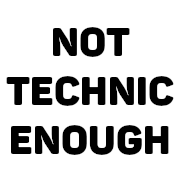
Flat subtractor [INSTRUCTIONS]
Sariel posted a topic in LEGO Technic, Mindstorms, Model Team and Scale Modeling
Few builders have ever needed a subtractor, I guess, but those who did will probably welcome a new, smaller and streamlined design. I've designed a bunch of subtractors before but they were all al least 3 studs tall. So this one is as flat as it gets. Free instructions with parts list included: http://sariel.pl/down/flat-subtractor.pdf And a totally biased video comparing it to a direct drive: -
transparent.thumb.png.64c75cc99e499bf757c13576b785e380.png)
[MOC] Compact gearbox with reverse
BrickDesignerNL posted a topic in LEGO Technic, Mindstorms, Model Team and Scale Modeling
I'm working on a small model that needs to revers it's pattern when it hits the end, and again when it's at the start (like auto-reverse in an old cassette deck). This is the first concept draft I made using only pieces from 51515-1 and no clutch gears and driving ring, and utilizing the "double bevel" feature of the gears. Resulting in a 2.5L instead of 5L gear width. How it functions The long axle turns, the 12 gear double bevel on the yellow axle can be pressed in two sides, press left and it turns in the same speed and direction, press right and it will turn in the opposite direction of the black axle. Part list and building instruction can be found here: https://rebrickable.com/mocs/MOC-65251/BrickDesignerNL/easy-push-to-reverse-gear/ TODO I would like the reverse to turn in the same speed as the forward. - so size will change -

[INSTRUCTIONS] for Episode I's AAT (from the Dark Side Developer Kit, set 9754) using BrickLink Studio
arturomoncadatorres posted a topic in LEGO Star Wars
The original Dark Side Developer Kit set (9754) came with three different booklets (1, 2, 3) with instructions to build a Droid Starfighter, a Destroyer Droid (aka Droideka), and an AT-AT. Additionally, they had pictures of the alternative builds. Among these, you could find the Armored Assault Tank (or AAT for short). I always liked this tank. I think it looked amazing, especially in Episode I’s Battle of Naboo. Thus, I was very excited to back-engineer the construction of this model. Fortunately, the booklet contained quite a few images, making the recreation a bit easier. I find the design of the build very interesting and clever: with only one motor, the AAT can move and make the turret look for a target. Overall, I am very happy with the results. I wanted other people could enjoy building this model as much as I did. You can find the actual instructions for it here.-
- aat
- instructions
-
(and 1 more)
Tagged with:
-

[MOC] Technic Attack Helicopter (Building Instructions)
makushima posted a topic in LEGO Technic, Mindstorms, Model Team and Scale Modeling
Lego Technic MOC - Attack Helicopter Building Instructions: https://play.google.com/store/apps/details?id=max.moc.technic.instructions.prime Lego Technic MOC - Attack Helicopter Lego Technic MOC - Attack Helicopter-
- attack helicopter
- helicopter
-
(and 3 more)
Tagged with:
-

[MOC] EXP.SUV - Update and new instructions
HorcikDesigns posted a topic in LEGO Technic, Mindstorms, Model Team and Scale Modeling
Then I realized, that this chassis behaves really well, and started thinking about it as about my new Overland Expedition (or Kostky Trophy) truck. (later I got reminded, that buggy motor is quite hungry, so it can not be used in this kind of event. But, with bigger battery... Have to try.) So, next step was the body. You can see that I experimented with new tire-rim combo. Too heavy, but not bad. And then I finally bought Buwizz. Laziness and worries about custom RC recievers and batteries won. (hope that not for all times :D) I also installed LEDs to the truck. And bought new tires. And finally, last week I took it outside. Hope you like it. :) More upgrades are slowly on the way. ;)- 15 replies
-
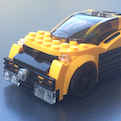
[MOC] Subaru WRX STI W/ Instructions
Touc4nx posted a topic in LEGO Technic, Mindstorms, Model Team and Scale Modeling
After 9 month of work, I present the completed version of my latest Moc, a 2019 Subaru WRX STI It features : AWD, with lockable central differential 6+R Sequential gearbox Fornt McPherson Suspension Rear double wishbone suspension, with anti-roll bar Working fake boxer engine Opening doors (front one with handle) Opening hood (or bonnet) Opening trunk Interior with detailed dashboard Decorated engine bay Render of the gearbox : Full driveline The belly shot The interior, with some detail, such as aerations. Engine bay, made to look as close as possible to the real one : It can also be built in white, with some minor adjustments. I also created Instructions for it. The instructions are made for the black one, but can, with minor adjustment be used for the white one. The instructions are 1218 pages long, handmade with Stud.io 2.0. You can download a sample here. Or look down here. You can Buy the instructions on Rebrickable. https://rebrickable.com/mocs/MOC-38243/Toucanx/subaru-wrx-sti/#comments And of course a video : I Hope you like it. If you have any question, don't hesitate, I will try to answer quickly. After this line, starts the WIP thread. ––––––––––––––––––––––––––––––––––––––––––––––––––––––––––––––––––––––––––––––––– Hi everyone, It's been a long time since I haven't posted on this forum, but today I would like to share a new project that I have started not so long ago. It's a Subaru Impreza WRX STI car that I will make. The list of what I will put in the car is the following : Awd Boxer 4 engine McPherson suspension for the front wheels Indépendant double whisbone for the rear wheels Lockable central differential 5 speed sequential gearbox I searched a bit for 5-speed sequential gearbox but I didn't found any. So I took a 4-speed gearbox design by @Rage_Hobbit (found there) and I added a 5th speed. Here is the result : You can download the .lfx. Note that you are supposed to place rubber band linking the orange pieces to the black one under the blue triangle. I have already made the boxer engine and most of the chassis. It will use these wheels : It's the one that are used in 42077 rally car. However I ran in a problem, it seems that the gearbox can not support the force involved in the transmission. The gears do a lot of skipping noises (doesn't sound healthy for the pieces). So I wanted to know if anyone knew a reliable 5-speed sequential gearbox / a 5+r sequential gearbox. That's it for today. More updates coming soon. -
It feels strange... but it seems to be done :) I don't know if anyone is still waiting for this, but if so, hear me out: The instructions are completed and available! Model Specifications: 1580 pcs./pzs. (1491 without stand) Weight: approx. 1 kg (2 lbs) Length: 44 cm (17 2/8") Width: 22 cm (8 5/8") Height: 13 cm (5 2/8"), + extra 10 cm (4") with stand I tried my best to design a detailed and accurate, yet relatively sturdy and swooshable model. Important (for me anyway) aspect is the exclusive use of currently produced and available parts (as of 2018). The average part cost I obtained during several attempts using BrickLink 'Easy Buy' option applied on the part list was ~ $180 + S&H from 2-5 stores. That's based in central Europe, buying only NEW parts and not optimizing for arbitrary colors of some parts. The lowest cost I have been able to reach was $140 + S&H, when buying all internal parts as 'non applicable' color. Safe to say I was pleasantly surprised by both price and the low number of required orders. Sure I might have been lucky, but over several tries in the span of last month or so, the number of different stores required to get the complete part list stayed consistently low. Building Instructions: 235 page high quality .pdf file Carefully crafted Stud.io based quality (if I say so :D) step by step instructions Preface containing (perhaps interesting) information about the model development, and helpful build notes and tips for increased building comfort Two part lists in .XML format are included, one for the ship, the other one for the stand I took way more time with this than I should have and a lot of that time was spent on inefficient fiddling with some unimportant detail :) Sorry about that, that's simply how I am. I hope that at least some of the effort was worth it ant someone will appreciate it. I decided to price it at $20 If you are interested in getting the instructions, please email me at kristofpucejdl@gmail.com Cheers! Kristof
- 44 replies
-
- venator
- instructions
-
(and 1 more)
Tagged with:




